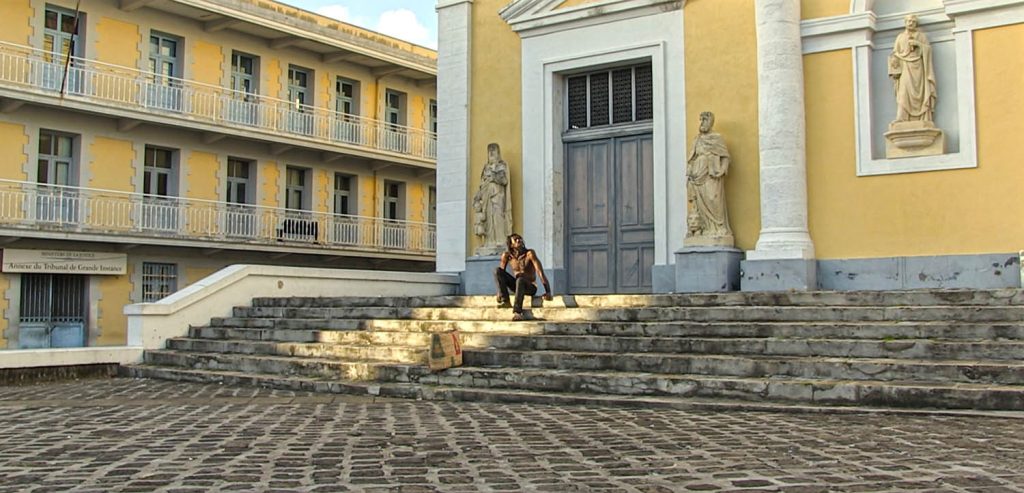Jonathan Ali talks to Malaury Eloi Paisley of Guadeloupe, director of L’Homme-Vertige: Tales from a City
Malaury Eloi-Paisley: “I believe that cinema is not separate from life”
In 2016, the filmmaker Malaury Eloi-Paisley began documenting Pointe-à-Pitre — her hometown and the administrative centre of Guadeloupe, a Caribbean department of France. Specifically, she filmed the lives of several people on its precarious margins. Eight years later, her intimate and ambitious tapestry of a film, L’homme-Vertige: Tales of a City, appears, a witness to these lives.
Through the compassionate lens of the filmmaker’s camera, we meet a series of indelible characters. There’s the elderly Ti Chal, who joined the Cuban Revolution and now suffers from lung disease. There’s also Eddie — a world-wise, homeless drug addict. And Eric, a stoic philosopher, walks his decaying city while reciting a series of searching literary texts. Taken together, these sensitive cinematic portraits form the poetic analogue of an island and a society.
Malaury Eloi-Paisley spoke to Jonathan Ali about the process of realising her quietly extraordinary film.
What prompted you to make this film?
I’m struck by the power of the encounters I have, and the characters whose paths I cross. Seers and prophets who inhabit the city of Pointe-à-Pitre and say something about us and our history. There was an urgency to address certain issues — unspoken aspects of society. “This monstrosity”, as the Martinican novelist Patrick Chamoiseau puts it.
What does “L’homme-Vertige” — literally, “Vertigo Man” — signify?
L’homme-Vertige is a poem. I’m influenced by Haitian literature, particularly Spiralism, which broke with the dictates of rational thought and linear narrative. The Haitian poet Frankétienne uses the rhythms of Creole language — a vivid language, rich in metaphors, with a unique musicality. He uses this term “vertige” a lot when he talks about the chaos of Port-au-Prince.
Similarly, I wanted to speak of our territory with our rhythms and our language. Vertigo is a state of anxiety bordering on madness. The men and women in my film witness the chaos of the world — the anguish of a society on the brink of the abyss — but hold on, unable to be knocked over. I was looking for a term that would embody this complexity.
How did you meet your participants, and what was the process of getting to know them like?
Because I believe that cinema is not separate from life, I met them because I am who I am. I see unique beings and there’s something about their way of being in the world that fascinates me. It’s the surge of curiosity that drives me towards others. Cinema is an alibi to maintain that bond, which might not exist otherwise — or that can only exist through cinema.
In addition to documenting the lives of its participants, the film is a witness to the urban evolution of Pointe-à-Pitre.
When I returned to live in Guadeloupe after several years abroad, the city was in the throes of change. There was little, if any, documentation of what was happening — the displacement and resettlement of the city’s inhabitants, some of whom can’t afford the new housing. There are numerous squats, abandoned buildings, and fires. To film the reverse side of Pointe-à-Pitre is to experience emptiness and immobility, while also to measure the consequences of history and successive policies adopted thousands of kilometres away in Europe.
The film also registers the independence movement, the UPLG (People’s Union for the Liberation of Guadeloupe). The movement’s flag is a repeated motif in the film and is prominent in the final shot.
The flag of independence is increasingly present in everyday life. When we started editing, I wondered how outsiders would understand that this is a colony. I told myself that French flags should be seen in the landscape. I thought there had to be obvious signs for people to understand the colonial presence. But this violence is everywhere — permeating architecture, bodies, words.
Is independence the solution?
I don’t think that’s the question. I don’t know what the solution to this violence is. I can only say that there are structural problems of a political, economic, and social nature. These are inextricably linked to the past with the French state, to the relations inherited from colonial society, to economic dependence, to the lack of a policy of food self-sufficiency, to unemployment, to the poisoning of the soil … the list is long. So far, France has not acted in our interests. Always this contempt, this feeling of superiority. What more can I say?
L’homme-Vertige: Tales of a City (2024)
Director: Malaury Eloi-Paisley
Guadeloupe • 93 minutes

